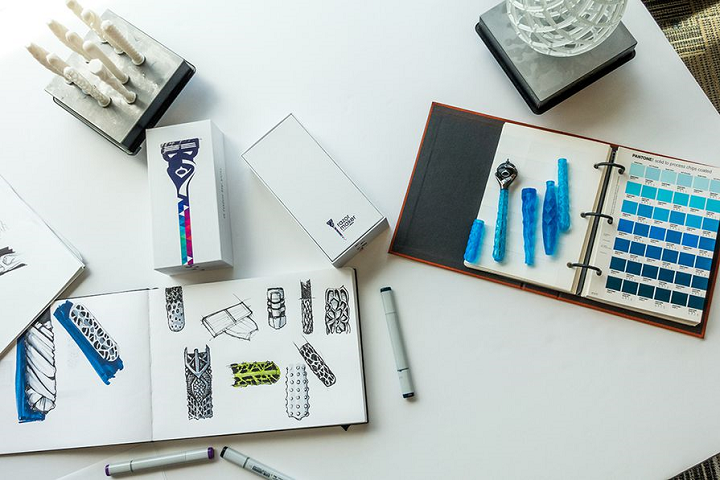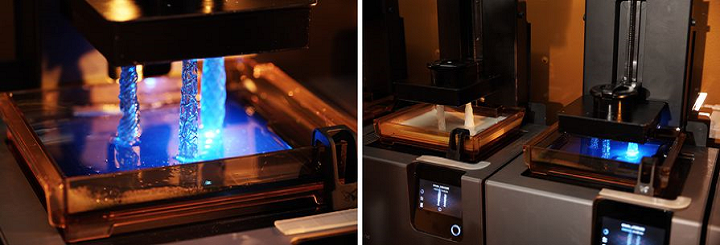Everywhere you look, there’s customization and personalization in the products we use daily – we consumers definitely like the items we use to reflect our preferences and personal tastes. And in today’s world of advanced manufacturing, it’s easier than ever to connect everyday products with personalized experiences to form bonds with customers…and get us to buy things, of course. Now, razor manufacturer Gillette is turning to 3D printing again, this time to pilot its new Razor Maker concept and open up consumer personalization with 3D printed razor handles.
The new platform is a great example of direct-to-consumer, end-use 3D printed parts, as Razor Maker is giving consumers the power to create and order their own customized razor handles. Fabricated on Form 2 3D printers, there are 48 different designs to choose from, with more coming later, along with a variety of colors; there’s even an option to add custom text to your razor handle.
Donato Diez, global brand manager for Gillette and Razor Maker co-founder, said, “Our partnership with Formlabs, and the power of their 3D printers, enable consumers to have a say on how their razors should look. We are excited to work with our Boston neighbors to pilot this breakthrough concept of customization.
“For Gillette, piloting Razor Maker represents a crucial step in our customization journey where new technology and new business models must come together in order to deliver products that are as unique as our consumers.”
Gillette’s Razor Maker concept brings design freedom to the final product in a new business model that could change how companies work across the whole product lifecycle. This is more than just a 3D printed razor handle, my friends – it’s a look at the future of mass-customized products.
Evan Smith, global product manager for Razor Maker, said, “We know consumers today are looking for brands that innovate in ways that let them express themselves – and that’s exactly what this pilot is all about.”
Razor Maker had to totally rethink its approach to manufacturing in order to deliver such customization. So back to the 3D printed razor handle itself – the first process steps are totally digital. First, the customer customizes their own unique handle through the platform’s website. Next, the final design is converted into a 3D file by Razor Maker.
Then, multiple design files are sent to a Form 2 3D printer to be printed at the same time in one batch. Once the handles are done printing, they’re washed, post-cured, coated, and assembled, before they’re shipped right to the customer’s door in 2-3 weeks.
“The Razor Maker concept allows us to create a new design, print and test it, and then the next day that design becomes a new handle available on the website. That was never possible before,” said Rob Johnson, a design engineer and Razor Maker co-founder.
 The designers of some of the original Razor Maker handles were inspired by many of the geometries and shapes often seen in architecture, nature, and even technology, but would be tough to reproduce through conventional methods of manufacturing.
The designers of some of the original Razor Maker handles were inspired by many of the geometries and shapes often seen in architecture, nature, and even technology, but would be tough to reproduce through conventional methods of manufacturing.
“It allows us to think about form in a way that was never possible before. In a traditional sense, we could only do one or two razor designs a year, whereas now we can have an idea, create it in 3D, print it, look at it, adjust it, and say that’s it,” said Rory McGarry, industrial design lead at Razor Maker.
Easy customization like this is one of the hallmarks of 3D printing, which Gillette previously only used for prototyping purposes. No tooling is required, there’s no up-front investment in molds, and the costs of having to produce several complex design iterations to find the optimal one are gone. It’s easy to scale custom manufacturing by just adding more 3D printers, and the lack of design constraints makes it easy for consumers to make razors that are entirely personalized – good news in a market where we see a lot of mass-produced stuff for sale.
Johnson said, “Combining our best shaving technology with the power and flexibility of 3D printing opens up a whole new world of product design possibilities.”
In addition to its new Razor Maker platform, Gillette is also working with Formlabs to possibly automate its 3D printing production processes. The company is one of the first testers of Form Cell, its relatively new automated production system.
Discuss this story and other 3D printing topics at 3DPrintBoard.com or share your thoughts in the comments below.
[Source/Images: Formlabs]Subscribe to Our Email Newsletter
Stay up-to-date on all the latest news from the 3D printing industry and receive information and offers from third party vendors.
Print Services
Upload your 3D Models and get them printed quickly and efficiently.
You May Also Like
Making 3D Printing Personal: How Faraz Faruqi Is Rethinking Digital Design at MIT CSAIL
What if your 3D printer could think more like an intelligent assistant, able to reason through a design idea, ask questions, and deliver something that works exactly the way the...
Reinventing Reindustrialization: Why NAVWAR Project Manager Spencer Koroly Invented a Made-in-America 3D Printer
It has become virtually impossible to regularly follow additive manufacturing (AM) industry news and not stumble across the term “defense industrial base” (DIB), a concept encompassing all the many diverse...
Heating Up: 3D Systems’ Scott Green Discusses 3D Printing’s Potential in the Data Center Industry
The relentless rise of NVIDIA, the steadily increasing pledges of major private and public investments in national infrastructure projects around the world, and the general cultural obsession with AI have...
Formlabs Teams Up with DMG MORI in Japan
In late June, Nick Graham, Chief Revenue Officer at Formlabs, announced on LinkedIn that the company had partnered with DMG MORI, one of the world’s leading machine tool companies, to...





































